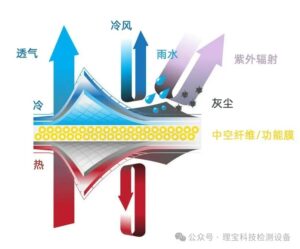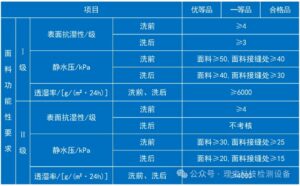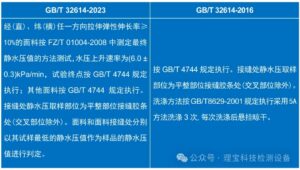What are the new changes in jacket testing? Interpretation of the latest GB/T 32614-2023 standard

Waterproof and breathable textile fabrics are used to make clothing for outdoor sports with waterproof and breathable functions.
In order to ensure the overall waterproof and breathable performance standards of the jacket products, requirements are put forward for the structural design, production process and fabric functionality of the jacket products.
 Placket
Placket Bottom Lapel
Bottom Lapel Waterproof zipper
Waterproof zipper
 Hydrostatic pressure test
Hydrostatic pressure test Water vapor transmission rate test
Water vapor transmission rate test Air permeability test
Air permeability test
- The sizes of adult jackets shall be selected in accordance with GB/T 1335.1 and GB/T 1335.2, and the sizes of children’s jackets shall be selected in accordance with GB/T 1335.3.
- If the value exceeds the range, it can be increased or decreased successively according to the classification values and principles specified in the above standards.
2. Perfluorinated compounds
In order to promote green and environmentally friendly products, the new standard adds products with nominal fluorine-free finishing, and the outer fabric needs to be tested for perfluorooctane sulfonyl compounds (PFOS) and perfluorooctanoic acid (PFOA).
- The standard requires that both PFOS and PFOA be less than 1.0 μg/m 2 .
- The test method shall be carried out in accordance with GB/T 311-26 .
PFOS and PFOA are both perfluoroalkyl and polyfluoroalkyl substances (PFAS). Relevant information shows that PFAS can cause potential harm to human health and may cause some human diseases such as cancer, liver damage, thyroid disease and developmental problems, and may cause cancer, weight gain or affect children’s development and immune system.
3. Pilling
The old standard (2016 edition) did not specify the test parameters; the new standard clearly adopts parameter D in GB/T 4802.1-2008 in the test method.
Compared with the new and old standard requirements, the upper installation remains unchanged, while the lower installation is increased to ≥15,000 times.

In the new standard, the light fastness index of dark-colored products (qualified products) is raised to ≥ level 3-4.
The new standard indicators are raised to: the moisture permeability of Class I products (before and after washing) ≥ 6000g/(m 2 ·24h), and the moisture permeability of Class II products (before and after washing) ≥ 4000g/(m 2 ·24h).
The new standard adds requirements for testing elastic fabrics and metal meshes in the hydrostatic pressure test method, specifically:
Fabrics with elastic elongation ≥10% in either warp (vertical) or weft (horizontal) direction shall be tested according to the method for determining the final hydrostatic pressure value in FZ/T 01004-2008, with a water pressure rise rate of (6.0±0.3) kPa/min, and the test endpoint shall be implemented in accordance with GB/T 4744; other fabrics shall be implemented in accordance with GB/T 4744. The hydrostatic pressure sampling location at the seam is the flat seam tape (except the cross section). The lowest hydrostatic pressure value of the fabric and the fabric seam is used as the hydrostatic pressure value of the sample for determination.

The washing method shall be in accordance with the washing method for surface moisture resistance in 6.1.18. The tensile elastic elongation shall be tested in accordance with FZ/T 01034, with a fixed force value of 25N.
8. Chromatic Aberration
The new standard adds relevant regulations and test methods for color difference
- The color difference of sleeve seams, hem seams and crotch seams shall not be less than Grade 3-4, and the color difference of other surface parts shall not be less than Grade 4. The color difference caused by multiple layers of fabrics or interlining shall not be less than Grade 3-4.
- The color difference between the top and bottom of the suit should not be less than 3-4 levels.
- The color difference test method shall be carried out in accordance with GB/T 250.

Read the original article: What are the new changes in jacket testing? Interpretation of the latest GB/T 32614-2023 standard
Statement:
The pictures in this article come from the Internet, and the copyright belongs to the original author. This official account is a learning and communication platform and is not used for commercial purposes. If there is any infringement, please inform us in time and delete it after verification. The content is the author’s personal opinion and does not mean that this official account agrees with his/her views. This is for learning and reference purposes only, and no guarantee is made as to the accuracy, reliability or completeness of the information; contact/contribution cooperation: [email protected]




